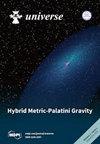利用 AXIS 进行 AGN 研究的前景:AGN 燃料--SMBH 邦迪半径内的热气体解析
IF 2.5
4区 物理与天体物理
Q2 ASTRONOMY & ASTROPHYSICS
引用次数: 0
摘要
超大质量黑洞(SMBH)周围的热气体应该被捕获在引力 "影响范围 "内,其特征是邦迪半径。钱德拉深度观测从空间上解析了附近五个超大质量黑洞的邦迪半径,这些黑洞被认为是以热吸积模式吸积的。早期的热吸积模型预测邦迪半径内的温度会急剧上升,与此相反,解析的温度曲线都没有出现这种上升。邦迪半径内的温度似乎很复杂,表明热气体的多温相,在大约 0.2-0.3 千伏时有较冷的成分。邦迪区域内的密度曲线较浅,表明存在较强的外流。这些发现可能可以用最近的现实数值模拟来解释,这些模拟表明邦迪半径内的大尺度增生可能是混乱的,较冷的气体在某些方向倾泻而下,而较热的气体则在其他方向外流。AXIS 的角分辨率与钱德拉类似,但收集区域要大得多,它将收集足够的光子来绘制大量活动星系核(AGN)样本 "影响范围 "内和周围新出现的吸积流。AXIS 将揭示最终为 AGN 提供燃料的流入流的转变,以及为环境提供反馈的流出流。本白皮书是 AXIS 探测器概念任务委托编写的系列白皮书之一;其他 AXIS 白皮书可在 AXIS 网站上查阅。本文章由计算机程序翻译,如有差异,请以英文原文为准。
Prospects for AGN Studies with AXIS: AGN Fueling—Resolving Hot Gas inside Bondi Radius of SMBHs
Hot gas around a supermassive black hole (SMBH) should be captured within the gravitational “sphere of influence”, characterized by the Bondi radius. Deep Chandra observations have spatially resolved the Bondi radii of five nearby SMBHs that are believed to be accreting in hot accretion mode. Contrary to earlier hot accretion models that predicted a steep temperature increase within the Bondi radius, none of the resolved temperature profiles exhibit such an increase. The temperature inside the Bondi radius appears to be complex, indicative of a multi-temperature phase of hot gas with a cooler component at about 0.2–0.3 keV. The density profiles within the Bondi regions are shallow, suggesting the presence of strong outflows. These findings might be explained by recent realistic numerical simulations that suggest that large-scale accretion inside the Bondi radius can be chaotic, with cooler gas raining down in some directions and hotter gas outflowing in others. With an angular resolution similar to Chandra and a significantly larger collecting area, AXIS will collect enough photons to map the emerging accretion flow within and around the “sphere of influence” of a large sample of active galactic nuclei (AGNs). AXIS will reveal transitions in the inflow that ultimately fuels the AGN, as well as outflows that provide feedback to the environment. This White Paper is part of a series commissioned for the AXIS Probe Concept Mission; additional AXIS White Papers can be found at the AXIS website.
求助全文
通过发布文献求助,成功后即可免费获取论文全文。
去求助
来源期刊

Universe
Physics and Astronomy-General Physics and Astronomy
CiteScore
4.30
自引率
17.20%
发文量
562
审稿时长
24.38 days
期刊介绍:
Universe (ISSN 2218-1997) is an international peer-reviewed open access journal focused on fundamental principles in physics. It publishes reviews, research papers, communications, conference reports and short notes. Our aim is to encourage scientists to publish their research results in as much detail as possible. There is no restriction on the length of the papers.
 求助内容:
求助内容: 应助结果提醒方式:
应助结果提醒方式:


